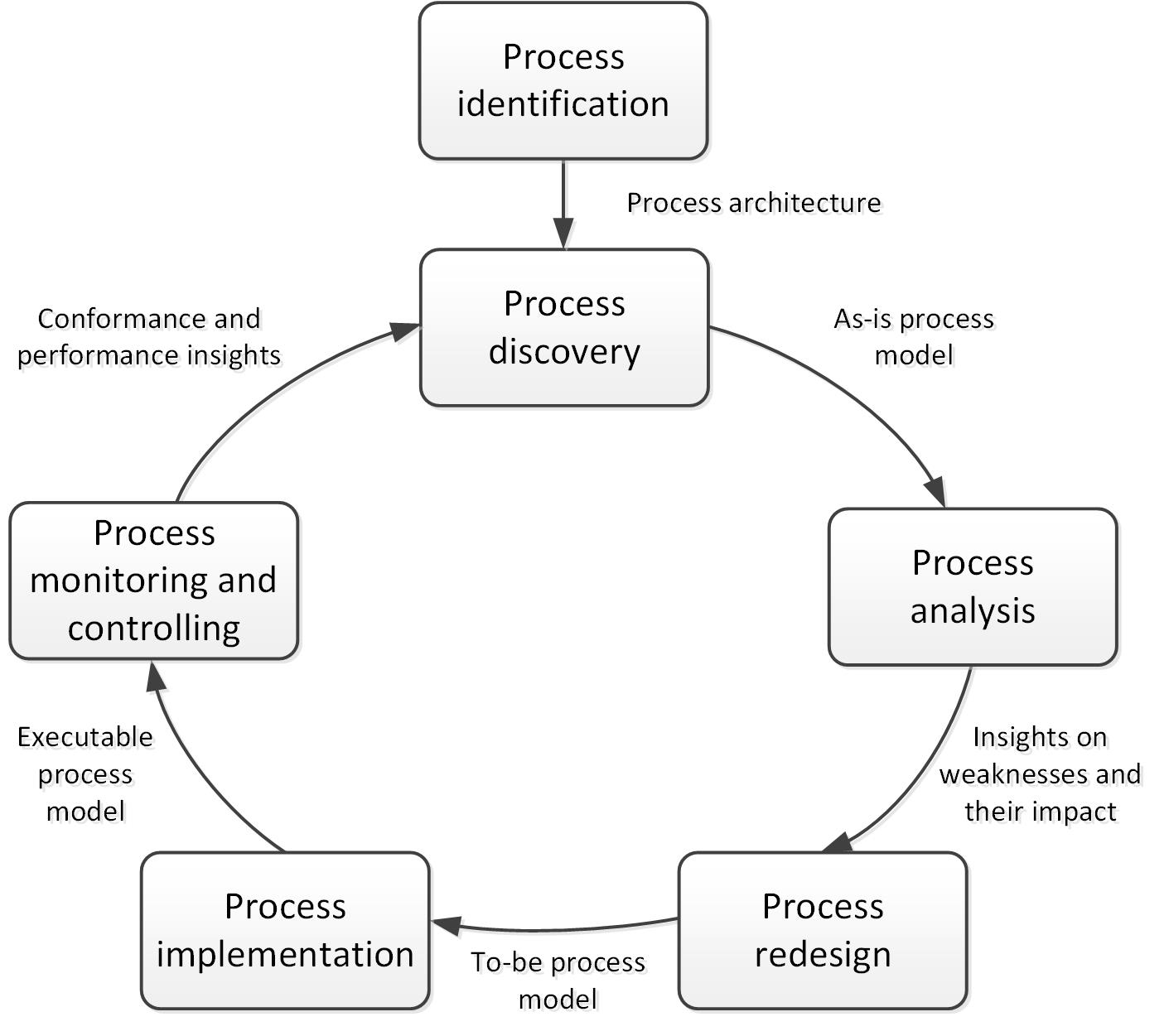1.4 - The BPM Lifecycle

- Step 1, PROCESS IDENTIFICATION: Which processes are we dealing with and how can we measure the outcome?
- Defining the start and end of a process to eliminate confusion. (as-is process)
- If the company has engaged in BPM initiatives in the past (parts) of the process will already be defined and documented.
- If the company has not engaged in BPM initiatives, it needs to identify the processes that are relevant to the problem/issue and define which relationships they have.
- Measuring value is a crucial step in BPM, because otherwise you cannot see the improvement the process has made.
- A process can be measured via:
- Cost related, Decreasing costs while keeping the same/better quality.
- Time related, Improving the cycle time (time to do a process), while keeping the same/better quality.
- Quality related, Reducing error rates (times processes end up in a negative outcome)/
- Defining the start and end of a process to eliminate confusion. (as-is process)
Step 2, PROCESS DISCOVERY: What is the process in detail?
- A outcome of this phase is to create a as-is process model. Which reflects the understanding that people in the organization have about how the work is done.
- Textual descriptions are difficult to read and easy to misinterpret. Diagrams make it much easier for everyone involved to understand. They also limit misunderstanding.
- In a diagram you can find the following:
- Swim-lanes: A flowchart is divided into several horizontal lanes. These each represent a organizational unit/person.
- Activity nodes: Units of work that represent a human or software application doing a specific task.
- Control nodes (gateways): Capture the flow of execution between activities. (decision/choice/check)
- Event nodes: Requires a action from an actor in order to proceed with the process.
Step 3, PROCESS ANALYSIS: What are the issues, and how can we resolve them?
- Identify and analyze potential remedies.
- Multiple remedies need to be looked at because a change in the process can cause other issues down the road.
- Changing a process is not as easy as it sounds, because people are used to work in a certain way.
- Sometimes to change a process in your own organization it requires a change in another organization. (for example with the providing more data to make a better choice)
Step 4, PROCESS REDESIGN: What is the improved process?
- A new process diagram is drawn to shown the organization. (to-be process)
- In the new diagram the issues are resolved.
- There could be multiple new process concepts. Each varies in the amount of work required to change, time it takes to implement the changes or what it costs to make the changes.
Step 5, PROCESS IMPLEMENTATION: What needs to be changed?
- For example, IT systems need to change and people need to be trained to use the new system at best.
- Complementary facets of change:
- Organizational change management
- Explain the changes in the process to the participants.
- Explain what changes are being made to the participants.
- Explain why the changes are beneficial to the company, to the participants.
- Put a change management plan in place in which you:
- Describe when the changes wil be put into effect
- Describe what transitional arrangements will be employed to address problems during the transition to the to-be process.
- Process automation
- Configuration of a existing IT system OR implementation of a new system.
- System should support process participants in their performance of tasks in the process.
- Which includes:
- Assigning tasks to process participants.
- Helping process participants prioritize their work.
- Providing process participants with the information they need to perform a task.
- Performing automated cross-checks and other automated tasks where possible.
- Organizational change management
Step 6, PROCESS MONITORING AND CONTROLLING: Do some adjustments to the process need to happen?
- Processes need to be monitored and analyzed to identify further adjustments/improvements to the process to better control the execution of the process.
- BPM should be seen as a circle because the outputs of the process monitoring make demands for more changes. Also because the ever-changing landscapes of customer needs, technology and competition.
Stakeholders in a BPM life cycle:
- Management team:
- CEO (Chief Executive Officer), responsible for overall business performance.
- COO (Chief Operations Officer), responsible for the way operations are setup.
- CPO (Chief Process Officer), responsible for process performance. (otherwise COO`s responsibility)
- CIO (Chief Information Officer), responsible for efficient and effective operation of information system infrastructure.
- CFO (Chief Financial Officer), responsible for the overall financial performance of the company.
- HRD (Human Resources Director), responsible when big numbers of process participants are involved.
- Process Owners:
- Responsible for efficient and effective operations of a given process.
- Planning, organizing, controlling, monitoring, securing resources, guidance (in resolving errors)
- One person could be responsible for multiple processes.
- Process Participants:
- Human actors who perform the activities of a business process on a day-to-day basis.
- Conducting of routine work according to standards and guidelines.
- Support redesign activities and implementation efforts.
- Process Analysts:
- Conduct process identification, discovery, analysis and redesign activities.
- Coordinate process implementation, process monitoring and process controlling.
- Report to management.
- Closely interact with process participants.
- Have an business or IT background depending on which change facet they focus.
- System Engineers:
- Involved in process redesign and implementation
- Interact with process analysts to capture system requirements.
- Can be a external contractor.
- BPM Group:
- Not all organizations have a dedicated BPM group.
- Preserving of process documentation.
- Knowledge of how to plan and execute an BPM project.
- Responsible for maintaining process architecture, prioritizing of redesign projects and giving support to other stakeholders of a BPM project.
- Management team: